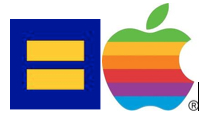 As soon as I heard about Apple Computer, I wanted to work there. Early on, I fell in love with the sleek elegant design, the beauty of the engineering and its brash young cofounder, Steve Jobs. And, as a young gay person, I was more than thrilled with a logo that featured a rainbow in the Apple. I was devoted to my Apple IIc and I was determined to work there.
As soon as I heard about Apple Computer, I wanted to work there. Early on, I fell in love with the sleek elegant design, the beauty of the engineering and its brash young cofounder, Steve Jobs. And, as a young gay person, I was more than thrilled with a logo that featured a rainbow in the Apple. I was devoted to my Apple IIc and I was determined to work there.
Even though I was in my early twenties, I had been gone from home a long time. I had finished high school in Europe, North Africa and the United States. I then took off for Hawaii to be near my first girlfriend and put myself through University of Hawaii in oceanography and political science. By the time I graduated, a tiny company, Apple Computer, was starting to poke its head above the horizon. I got every friend I knew to work there, including my sister who I sponsored into the country from Canada.
I had to make a living so I focused on law schools near Apple and got a scholarship to Santa Clara School of Law in the heart of Silicon Valley. During law school, my friends would routinely sneak me into product announcements and take me to Apple parties. I saw Steve in action many times and was more resolved than ever that this is where I belonged. When I was about to graduate from law school, I wrote and asked to meet with Apple's General Counsel. (Like Steve, who in the 8th grade wrote to David Hewlett to get some parts to complete an electronics project, I just assumed anyone would want to meet to me.) The GC nicknamed "Pepsi" said the equivalent of: "We would love to have you, kid -- problem is you don't know anything. Go get a job and come back in a few years."
After working at Apple's outside law firm, I finally got to join Apple in the late 1980s. While Steve had been ousted, his brilliance and magic still permeated the place. Not for long. That energy dissipated over time as people clutched, genius-free, for new ideas. Those sparking catalytic ideas for transforming life as we know it eluded the mere morals left behind. Innovation waned and probably the best symbol of Apple's inherent inability to match engineering, design with practical application was the failed Newton, an early handheld device that was vastly over-hyped and nowhere near ready for prime time.
To understand Steve Jobs fully, one only needs to see the early videos that capture what he saw one day at the Xerox Palo Alto Research Center (PARC). There you will see Alan Kay (later an indispensible figure in the creation of the Macintosh) discovering an intuitive approach to computing through the observation of children at play. It was children that gave us our basic computing vocabulary when using a Graphical User Interface (GUI) --- they would call the little device they used to manipulate the screen a "mouse" because it had a long tail. They would open boxes and call them "windows." But it took the keen eye of Steve Jobs to understand how to commercialize these ideas in a way that could put the power of computing into the lives of millions and millions of people. It was a revolution. He put the power of computing into the hands of the people. That was his genius. He did not invent things -- he conceived of solutions built of disparate parts and then gave birth to them in a way that exploded into entire new ways of living.
I left Apple in 1994 to head the Human Rights Campaign, an LGBT advocacy organization. Everything I learned at Apple informed what we did at HRC. At HRC, we never lost sight of the need to have programs, projects and products planned and designed down to the kernel. While we were in the social change business, we brought in sparkle and color, with a great fresh look and feel -- while launching the now ubiquitous HRC Logo, a simple equal sign.
And in everything we did we served the end user -- the LGBT person who needed hope, support and knowledge at home, at work and in the communities where they lived. We strived to change the country, and in no small measure, we succeeded. Not us alone, because change depends on millions of small acts of courage every day as younger and younger people came out and latched on to their strength with self esteem in tact sooner. But the team had a dramatic impact and I have one person to thank for the greatest lessons of my life: Steve Jobs. This is how Steve affected just one person and where those lessons were applied. I do believe Apple is in good hands -- Tim Cook's -- But, I cannot quite yet imagine a world without him.
Elizabeth Birch is the former head of Litigation for Apple Computer, Inc. and General Partner of True Blue Inclusion, a global diversity and inclusion firm.